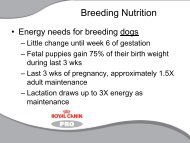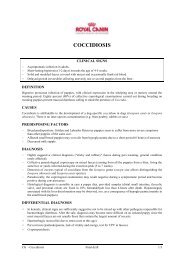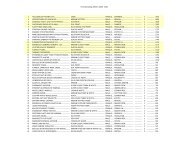Guide to Preventing Parasites.pdf - Royal Canin Canada
Guide to Preventing Parasites.pdf - Royal Canin Canada
Guide to Preventing Parasites.pdf - Royal Canin Canada
Create successful ePaper yourself
Turn your PDF publications into a flip-book with our unique Google optimized e-Paper software.
- In animals that are unprotected during the transmission season and that might be<br />
harbouring parasites aged 10 weeks or older, monthly treatment for an entire year should<br />
be initiated immediately.<br />
- A lack of efficacy has been reported for all the macrocyclic lac<strong>to</strong>nes used in canine<br />
heartworm disease prophylaxis. An annual screening test is therefore strongly<br />
recommended.<br />
- For adulticide treatment, it is strongly advisable <strong>to</strong> administer a first dose of<br />
melarsomine, followed four <strong>to</strong> six weeks later by two doses separated by a 24-hour<br />
interval. This pro<strong>to</strong>col lowers the risks inherent in the treatment.<br />
- Microfilaricide treatment is initiated as soon as a diagnosis is made. Milbemycin seems<br />
<strong>to</strong> be the drug with the greatest microfilaricidal effect. After the fist dose is administered,<br />
the dog should be moni<strong>to</strong>red because of the risk associated with the death of a large<br />
number of microfilariae. Major reactions were observed in dogs whose microfilaria count<br />
had been estimated <strong>to</strong> be as low as 5,000 per millilitre of blood (30 <strong>to</strong> 40 microfilariae per<br />
microscope field at x10 magnification in the filtration test). The reasons for initiating this<br />
treatment before administering an adulticide are <strong>to</strong> reduce the number or circulating<br />
microfilariae, <strong>to</strong> eliminate the migrating third- and fourth-stage larvae, and <strong>to</strong> reduce the<br />
adult worm mass by inhibiting the female’s reproductive system. In addition, it is not<br />
known how effective melarsomine is against larvae aged 4 months or less. The risk of<br />
thromboembolism during subsequent adulticide treatments will be reduced accordingly. It<br />
is advisable <strong>to</strong> delay adulticide treatment for six months.<br />
- The long-term use (12 months) of a macrocyclic lac<strong>to</strong>ne is beneficial in animals that are<br />
infected but that display no clinical signs and have very few or no radiologically<br />
documented pulmonary lesions and few or no microfilariae. Ivermectin seems <strong>to</strong> give the<br />
best results in such cases, mainly because if its long-term lethal effect on young adult<br />
worms. However, this approach does not seem <strong>to</strong> bring about improvement in chronically<br />
infected animals with major clinical signs. If this type of treatment is administered <strong>to</strong><br />
such an animal, it is important <strong>to</strong> do a follow-up two or three times a year.<br />
- Certain macrocyclic lac<strong>to</strong>nes now have a residual effect that makes them more<br />
effective, but for now, it is not advisable <strong>to</strong> lengthen the interval between treatments.<br />
Additional comments<br />
Annual screening test for all dogs: It has been shown that drugs cannot provide 100%<br />
protection against heartworms. This is probably the only reason why the AHS has called<br />
for a shorter interval between screening tests. Before applying this measure <strong>to</strong> all dogs,<br />
one should take the following points in<strong>to</strong> consideration. Even a low parasite load can lead<br />
<strong>to</strong> the appearance of microfilariae in the blood and permit transmission of the infection,<br />
which goes against the main objective of our intervention. If infection occurs, it will, in<br />
all probability, be by a small number of worms, which do not constitute a threat <strong>to</strong> the<br />
38







